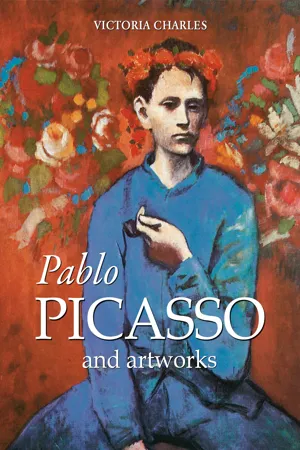
- 73 pages
- English
- ePUB (mobile friendly)
- Available on iOS & Android
eBook - ePub
Pablo Picasso and artworks
About this book
Picasso was born a Spaniard and, so they say, began to draw before he could speak. As an infant he was instinctively attracted to artist's tools. In early childhood he could spend hours in happy concentration drawing spirals with a sense and meaning known only to himself. At other times, shunning children's games, he traced his first pictures in the sand. This early self-expression held out promise of a rare gift. Málaga must be mentioned, for it was there, on 25 October 1881, that Pablo Ruiz Picasso was born and it was there that he spent the first ten years of his life. Picasso's father was a painter and professor at the School of Fine Arts and Crafts. Picasso learnt from him the basics of formal academic art training. Then he studied at the Academy of Arts in Madrid but never finished his degree. Picasso, who was not yet eighteen, had reached the point of his greatest rebelliousness; he repudiated academia's anemic aesthetics along with realism's pedestrian prose and, quite naturally, joined those who called themselves modernists, the non-conformist artists and writers, those whom Sabartés called "the élite of Catalan thought" and who were grouped around the artists' café Els Quatre Gats. During 1899 and 1900 the only subjects Picasso deemed worthy of painting were those which reflected the "final truth"; the transience of human life and the inevitability of death. His early works, ranged under the name of "Blue Period" (1901-1904), consist in blue-tinted paintings influenced by a trip through Spain and the death of his friend, Casagemas. Even though Picasso himself repeatedly insisted on the inner, subjective nature of the Blue Period, its genesis and, especially, the monochromatic blue were for many years explained as merely the results of various aesthetic influences. Between 1905 and 1907, Picasso entered a new phase, called "Rose Period" characterised by a more cheerful style with orange and pink colours. In Gosol, in the summer of 1906 the nude female form assumed an extraordinary importance for Picasso; he equated a depersonalised, aboriginal, simple nakedness with the concept of "woman"...
Frequently asked questions
Yes, you can cancel anytime from the Subscription tab in your account settings on the Perlego website. Your subscription will stay active until the end of your current billing period. Learn how to cancel your subscription.
No, books cannot be downloaded as external files, such as PDFs, for use outside of Perlego. However, you can download books within the Perlego app for offline reading on mobile or tablet. Learn more here.
Perlego offers two plans: Essential and Complete
- Essential is ideal for learners and professionals who enjoy exploring a wide range of subjects. Access the Essential Library with 800,000+ trusted titles and best-sellers across business, personal growth, and the humanities. Includes unlimited reading time and Standard Read Aloud voice.
- Complete: Perfect for advanced learners and researchers needing full, unrestricted access. Unlock 1.4M+ books across hundreds of subjects, including academic and specialized titles. The Complete Plan also includes advanced features like Premium Read Aloud and Research Assistant.
We are an online textbook subscription service, where you can get access to an entire online library for less than the price of a single book per month. With over 1 million books across 1000+ topics, we’ve got you covered! Learn more here.
Look out for the read-aloud symbol on your next book to see if you can listen to it. The read-aloud tool reads text aloud for you, highlighting the text as it is being read. You can pause it, speed it up and slow it down. Learn more here.
Yes! You can use the Perlego app on both iOS or Android devices to read anytime, anywhere — even offline. Perfect for commutes or when you’re on the go.
Please note we cannot support devices running on iOS 13 and Android 7 or earlier. Learn more about using the app.
Please note we cannot support devices running on iOS 13 and Android 7 or earlier. Learn more about using the app.
Yes, you can access Pablo Picasso and artworks by Victoria Charles in PDF and/or ePUB format, as well as other popular books in Art & Artist Monographs. We have over one million books available in our catalogue for you to explore.
Information
Topic
ArtSubtopic
Artist MonographsTable of contents
- Pablo Picasso, Photograph, 1904
- Study of a Nude seen from the Back, 1895
- The Absinthe Drinker, 1901
- Woman with a Helmet of Hair (An Acrobat’s Wife), 1904
- Boy Leading a Horse, 1906
- Green Bowl and Black Bottle, 1908
- Musical Instruments, 1913
- Tavern (The Ham), 1914
- Composition Bowl of Fruit and Sliced Pear, 1914
- Bowl of Fruit with Bunch of Grapes and Sliced Pear, 1914
- Portrait of a Young Girl (Woman Seated in Front of a Fireplace), 1914
- The Bathers, 1918
- Women Running on the Beach, 1922
- Paul as Harlequin, 1924
- The Kiss, 1925
- The Crucifixion, 1930
- The Sculptor, 1931
- Figures on the Beach, 1931
- The Lecture, 1932
- The Bullfight, 1933
- Weeping Woman, 1937
- Portrait of Marie-Thérèse Walter, 1937
- The Supplicant, 1937
- Guernica, 1937
- Portrait of Dora Maar, 1939
- The War, 1952
- The Peace, 1952
- Portrait of Jacqueline with Flowers, 1954
- Women of Algiers (after Delacroix), 1955
- Les Ménines (after Velázquez), 1957
- Woman with a Hat (Half-Length), 1962
- Déjeuner sur l’herbe (after Manet), 1962
- The Kidnapping of the Sabines, 1963
- The Painter and His Model, 1963
- Portrait of Jacqueline, 1963
- Self-Portrait (Head), 1972